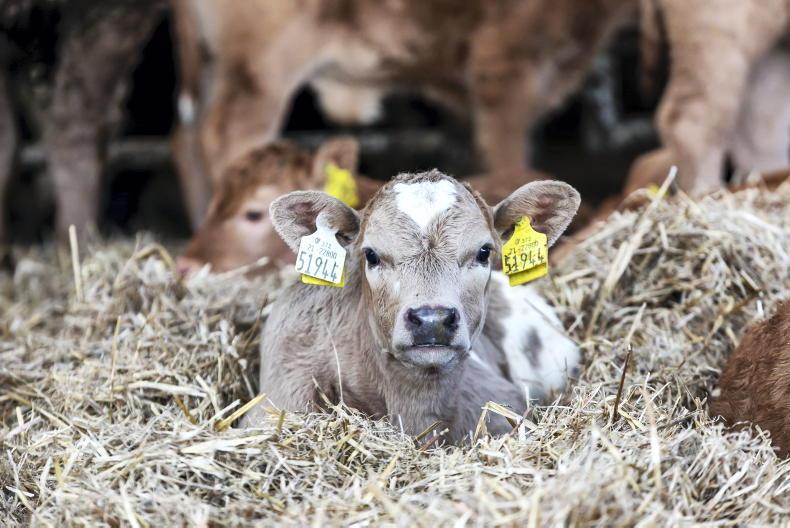Calving has accelerated in the past week on Tullamore Farm, as mature cows start to calve.
The majority of calvings in the first seven to 10 days of this year’s season came from two-year-old first-calved heifers.
These heifers were synchronised and artificially inseminated (AI-ed) on a fixed time programme, with the 18 heifers calved to date all inseminated on 18 April 2024.
Despite all being AI-ed on the same day, a spread of eight days was observed, with nine heifers who were in-calf to sexed semen, along with any other heifers carrying female calves, calving first.
There was no mortality to report in this bunch, but, that being said, as expected when calving heifers, a higher level of assistance was required.
Two heifers were offered voluntary assistance with just the aid of calving ropes, while three heifers required slight assistance with the calving jack.
23 month old curaheen gunshot heifer, €137 rep.index, bred from an Auroch Deuter X F1 limousin cow.. done 1.43kg/day to weaning. Brooklands Marco heifer calf (sexed female straw). A very powerful heifer from birth. pic.twitter.com/Vl3trMaFRU
— Shaun Diver (@diver_shaun) February 1, 2025
One heifer required a C-section due to a calf being malpresented, restricting the heifer from opening up fully for calving.
With these slight, but not entirely unexpected, issues put aside, calves have been born healthy and quick to suckle, with heifers all thankfully having plenty of colostrum and milking well since.
Ten mature cows have now calved with no assistance required and with only one issue to report - one calf contracted a navel infection and antibiotics have been administered and the calf is doing well.
Sexed semen played a big role in the early stages of breeding 2024 and has delivered positively, with 24 out of 29 calves born being female.
Countdown to lambing
The majority of ewes on the farm are now housed, with just 31 Easycare ewes and 52 in-lamb yearling hoggets at grass.
Ewes have been penned up according to litter size and are now being fed accordingly. Ewes were scanned on the first week of January.
This is an important task to give a measure of breeding performance and to allow for proper management of ewes pre-lambing.
The day of pregnancy scanning does not come around without bringing the worries of poor results. However, thankfully, this year’s reports are positive, with good results attained.
The farm traditionally ran a predominantly Mule ewe flock with the aim of driving prolificacy. This was very much the case in the early years of the project, with Mule ewes scanning above 200% with low barren rates.
However, in 2021, the pregnancy scan revealed disappointing results, with an unexplained spike in the barren rate at 10.4%.
At the time, the management team, along with farm vet Donal lynch, explored every avenue possible to shed light on the high barren rate.
Issues
Ewes were in adequate body condition score (BCS) and fertility issues with rams were ruled out. Liver samples were taken from culled ewes for mineral analysis. Blood tests were taken from live ewes to check for underlying health issues, but to no avail.
No pinpoint reason was identified as the cause of the high barren rate.
In the years subsequent to this, we have struggled to bring barren rates back to an acceptable level, with the barren rate generally sitting at 6% to 7%.
However, this year, barren rates have fallen back to a level deemed acceptable, with 3.45% of mature ewes scanning empty across all breeds.
The performance of the Mule ewes in the flock has returned to performance expected from the breed, with this bunch scanning 1.94 lambs/ewe joined, while the barren rate was low in this bunch at 1.45%.
Litter size is broken down as follows - 57.7% of ewes scanned with twins, 14.49% of ewes carrying triplets and 23.19% singles.
Mule-crosses
Since the early days of the project, the farm has been retaining a number of its own replacements from Texel and Suffolk ewe lambs bred from Mule ewes.
Mature second-cross ewes have consistently scanned at a higher rate than expected at around 1.85 to 1.9 lambs per ewe in previous years.
However, this year, scan results from this bunch have been quite disappointing at 1.6 lambs/ewe joined. A higher barren rate of 7.69% in this bunch has had a significant impact on scan results.
With barren ewes removed from this bunch, the in-lamb rate rises to 1.75 lambs/ewe, which is still somewhat behind previous years’ performance. Litter size in this bunch is made up of 60% twins, 33% singles and 6% triplets.
Easycare genetics
The introduction of Easycare genetics to the flock in 2024 is always a big talking point with groups that have visited the farm throughout the year and has generated a lot of interest in what these ewes are capable of.
Easycare sheep may be known more for their wool-shedding traits rather than high prolificacy, but do seem to be delivering on both fronts on Tullamore Farm.
This bunch of mature ewes, albeit a small number of 22 ewes, scanned at a rate of 2.09 lambs per ewe with zero empties. When broken down, 72% of Easycare ewes are carrying twins, 18% carrying triplets and 9% carrying singles.
Easycare twin ewes remain out on #TullamoreFarm received foot rot vaccine yesterday, meal will be introduced soon pre housing. Stay tuned!! @FJSheep pic.twitter.com/jdUb0EuT9y
— Shaun Diver (@diver_shaun) February 12, 2025
The farm has traditionally lambed down replacement ewe lambs as yearling hoggets. The 2023-born ewes in the flock, having reared lambs in 2024, recorded positive results, scanning at 1.84/lambs/ewe joined across all breeds present, despite being in poorer condition than normal at the time of weaning due to a poor grass growing year in 2024.
This year, 69 ewe lambs joined with rams for a three-week breeding season, with 52 ewe lambs scanning in-lamb returning an in-lamb rate of 1.28 lambs/ewe.







 This is a subscriber-only article
This is a subscriber-only article










SHARING OPTIONS: